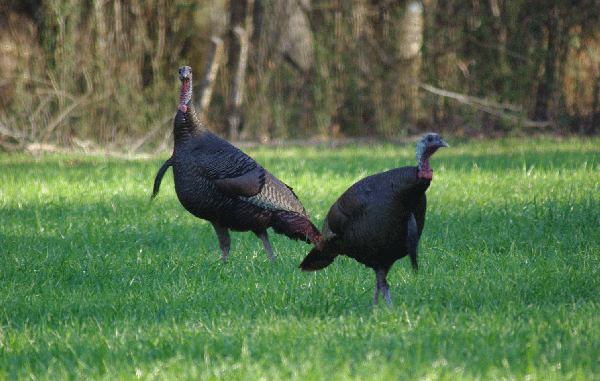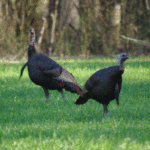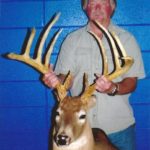
Attention now turns to contests, turkeys
The deer hunting is over and it’s time to talk turkey. But before the gobbling and clucking begins, the 33rd Annual Louisiana Sportsmen’s Show & Festival will take place in Gonzales on March 9-11, and it is time to look at some of those deer heads that were featured in the Deer of the Year story in last month’s issue.
A few years ago I was measuring deer heads at a show in Shreveport. There were some pretty good racks hanging on the display board, and I was busy measuring another one when I looked up and saw this fine-looking North Louisiana lad decked out in his best western attire — jeans, jacket, boots and big cowboy hat. He looked at me and, with his best North Louisiana accent, said, “Hey mister, can I look at them deer heads?”
I stopped what I was doing and struck up a conversation with the young man. He was around 10 years old and did hunt deer but had not killed anything big yet. No doubt he has probably taken care of that matter by now.
The 2011-12 season had to be pretty good based on the three pages of photographs in the magazine last month. But I’m still hearing a lot of talk about how bad it was. Hunters were not seeing many deer, and it appears the overall deer harvest may be down.
Last year was a slow season for me as far as killing deer; this year wasn’t spectacular, but I did kill more deer than the 2010 season. The key to seeing deer this year was to be in the woods where the acorns were because that is where the deer were.
The action at the feeders and food plots just was not happening based upon the 40 or so deer stomachs I looked at. From the first stomach in October to the last stomach in January, the main food item to be found was the acorn. It was only until the end of the season that I started finding some corn and food plot vegetation in the stomachs.
Cherry bark oak, white oak, cow oak and striped oak acorns were the ones the deer were selecting. The water oak mast was very abundant, but deer were choosing the other acorns first, but it appears the white oak crop is gone and deer will be eating these acorns well into the spring.
The abundant mast crop made hunting a little difficult — deer simply did not have to move far to find acorns — and with the mild winter, the native browse provided deer with the green forage needed. The rains finally came, and the January patches with the moisture and warm temperatures turned green and will also provide deer with some good nutrition prior to spring green-up, which looks to be happening now.
There seems to be some confusion among hunters about having deer officially scored for the state record book or the Boone & Crockett or Pope & Young record books. To be officially scored, the rack of the buck has to air dry for 60 days. This time period does not include freezer time, obviously, since drying cannot take place in a freezer. Official measurers can score racks on mounted bucks or they can score the rack itself if the taxidermist has not mounted it. Most official measurers, including me, do not like to green score deer since it means nothing because of the drying requirement and if it does score well it will just have to be measured again.
The Sportsmen’s Show in Gonzales is the first chance for hunters to have their deer heads measured. Another opportunity is the contest at Bowie Outfitters in Baton Rouge. The grand prize at these contests is determined by a random drawing of all those who enter a deer head, big or small.
It’s interesting to watch people look at the heads during a show. You would be surprised how many times I am asked if any of the heads are from Louisiana. We do grow some trophy-class deer in this state, and this is the opportunity to see them.
I often hear some hunters comment that they should have brought their deer because it is bigger than most of them hanging up. Well now is the time to get the “tale of the tape” and find out just how good your deer is. A typical buck killed with a gun that scores 130 or better will qualify for the Louisiana Big Buck Record list for 2011, and a buck that was killed with a bow and scores 110 will make the state list for that category. The Sportsman contest has categories for Louisiana Gun and Bow, Youth, Ladies, Out-of-State Gun and Bow and a Muzzleloader/Crossbow category.
The official scoring technique for the state and national records involves deductions for the lack of symmetry, even with bucks that are measured in the non-typical category. Hunters often do not understand this and are disheartened when their state record buck is actually not a new state record. Any buck that scores 160 typical or 185 non-typical is a great deer; in fact, it is a deer of a lifetime and certainly one that a hunter should be proud of.
The statewide turkey season opens March 24. It is time to start thinking about cleaning up the feeders and making sure there is no bait on the ground. An area is considered to be baited for 15 days once the feed has been removed. Feeders can be left out and on, but there is no turkey hunting within 200 yards of these sites.
With the abundant mast crop, the turkeys really do not need to be fed; food plots that have grass and clover will attract the birds anyway. One thing I like to do is to prepare the strips that I am going to plant for the spring and summer in February.
Turkeys like to scratch around in the bare ground, and this is a good way to give them a site for doing this. Another activity that may be beneficial is to clip the winter grass if it is too tall and thick for the turkeys to move around in while feeding.
It has been fun to watch the turkeys during the deer season. I am always amazed at how vocal the birds are as they move around in their daily routine. It is really neat to watch and listen to a group of turkeys get back together after being flushed from the roost. It seems like they like to roost in the pines along the woods trail to one of my deer stands.
Birds are purring, kee-keeing and making a lot of other soft sounds as they move toward other birds in the woods. Even the gobblers can make these soft calls. This is something to keep in mind while hunting. While sometimes it takes some loud calling to get a bird excited, a little bit of soft calling and a lot of patience is sometimes just what is needed to put a tag on a tom.




